It was very easy to decide the front side of this material because the trunk base line is good. And it has the first and second curves which are very suitable for the mini bonsai. Though the next problem is to make the core of the tree, the taper is so good that I think that it is the most suitable material as a mini bonsai.
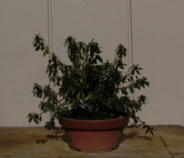
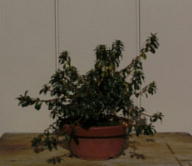
The photos were taken on January 16th. The former is the front side of this material and the latter is the back side.
Though the problem was to choose the shoot which was the most suitable for the core of the tree, since it had a lot of shoots, at first I removed some unnecessary shoots. But since the distance between the second curve and the bottom of the longest shoot is short, I could not decide it as the core of the tree.
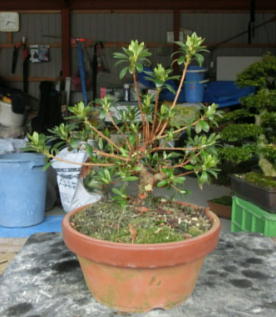
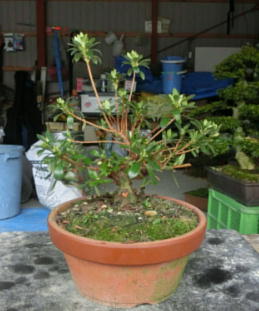
The photos were taken on March 17th. The former is front side of this material and the latter is the back side.
Therefore I kept the shortest of the three shoots to make it into a temporary core of tree. If it will have a good shoot, I will cut it there to make a new core of the tree.
But if the trunk will grow very thick, the image of the tree may change: the longest shoot may be OK though I will cut it very short. These three shoots are the safety for the future. If it will pass three years, two of them will be unnecessary and cut. I think that it is an important idea.
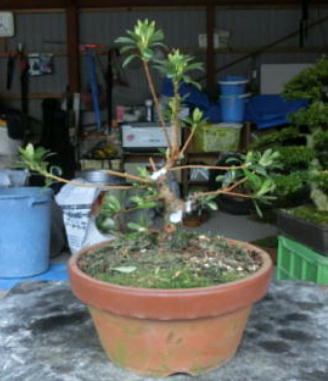
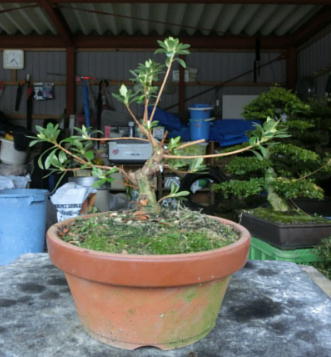
The photos were taken on March 17th. The former is front side of this material and the latter is the back side. Though the height (the top of longest shoot) is 20 cm, it will be about15 cm in 3 years.
Section 2. The young tree of Shuho no hikari as a material
This material was one of some slips which I had grown to make roots of the large trees of Shuho no hikari in the nursery. Since I succeeded in grafting the saplings on the bottoms of trunks, I have kept it in the pots. Though I have other young tree of this variety, I cannot make it into a small bonsai because the distance between the bottom of trunk and the first curve is more than 10 cm. If it will have a good shoot near the bottom of trunk in the future, I may be able to make it into a mini bonsai.
When I transplanted some saplings of Shuho no hikari into pots from the seedling tray, finding the good shoot on the trunk of one of them to make the first curve near the bottom, I cut the trunk there. Therefore now the taper of this material is good. And it was very easy to decide the front side.
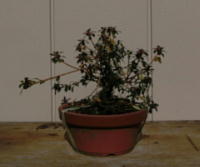
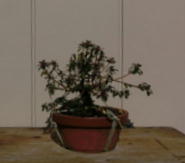
The photos were taken on January 16th. The former is the front side of this material and the latter is the back side.
Since I repotted this material last year after pruning it, it does not have any thick branches except a thick one on the back side of the trunk. Therefore at first I removed unnecessary shoots and examined the stream of the trunk.
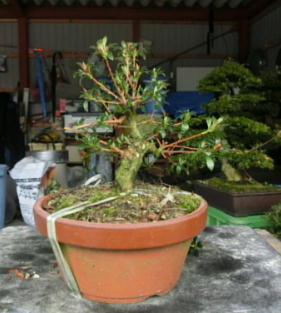
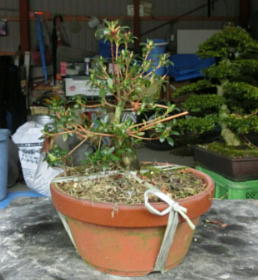
The photos were taken on March 17th. The former is front side of this material and the latter is the back side.
Since the stream of the trunk is good and I found the shoot which was suitable for the core of the tree, I cut the trunk there to make the second curve. And I cut the necessary shoots short and remove the thick branch on the back side of the trunk. Now I can hope that it will be a good mini satsuki bonsai if the trunk will be thick in five years.
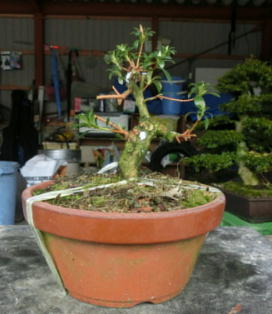

The photos were taken on March 17th. The former is front side of this material and the latter is the back side. The height is 14 cm.
Section 3. The young tree of Hikorin as a material
Though two large trees of Hikorin have been planted in the nursery since 22 years ago, I did not have any young tees in the pots. Therefore I inserted a lot of cuttings into Kanuma soil in the seedling tray to keep some of them and to give the rest to our relatives and friends. Now I have 6 young trees.
Pruning two of them, I wired them, made them into a cascade style and repotted them in the high pots in the last spring to introduce how to make young trees into a cascade style on my web site. And I published it in “Satsuki and Other Trees in the Mack’s Garden 26” on December 7th, 2014.
And I have other four young trees of Hikorin. After pruning and wiring two of them, I made them into a cascade style three years ago. Therefore I have to repot them after blooming in July. Since they already had the basic style of cascade, I could not use them as the materials for my web site last year. And since one of them is like a bush and does not have any good points to make it into a small bonsai now, I cannot use it as a material. Therefore I used the last one as a material to make it into mini bonsai.
The trunk base line of this material is not good, either, because I did not wire all saplings of Hikorin when they were transplanted into the pots from the seedling tray. But since it has the first curve which is very loose, it was easy to decide the front side.
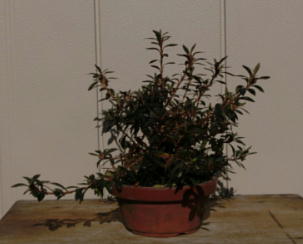
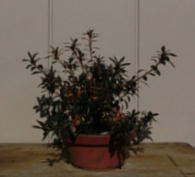
The photos were taken on January 16th. The former is the front side of this material and the latter is the back side.
Though the taper of this material is not bad, the stream of the trunk is so loose that I had to decide whether I could use it as a material or not after considering the planting angle.
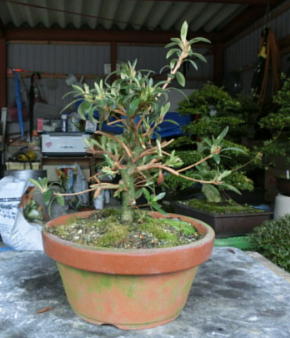
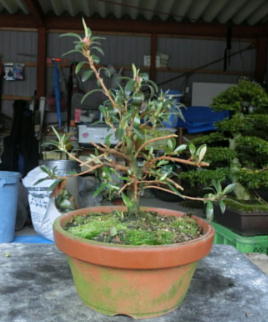
The photos were taken on March 17th. The former is front side of this material and the latter is the back side.
Therefore I removed unnecessary braches and shoots, and cut some necessary branches and shoots short to see the whole figure clearly. Judging from the stream of the trunk, I decided to make this material into a mini bonsai because I thought I could make the third curve and the top of the tree. And I kept some shoots to make the apex. Especially one of them was very long. It was because I could not decide which shoot was the core of the tree.
Then, I tried wiring one of them which I thought to be suitable for the core of the tree. Since I could make the third curve, the whole figure is not bad though the stream of the trunk is very loose.
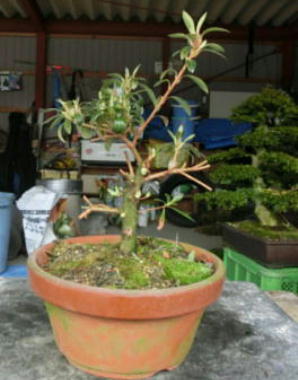
The photos were taken on March 17th. This photo is the front side of this material.
Therefore I cut the long shoot very short to keep it as a safety. But if the trunk will grow thick, it may be better than the present core of the tree. And making this material into a small bonsai, I think that it may be better if the distance between the second curve and the third one will be a little bit shorter than now. In short, we have to have an image of the completed bonsai at the present time when we are styling a young satsuki tree.
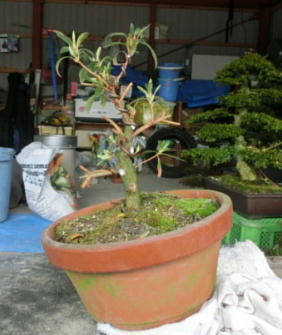
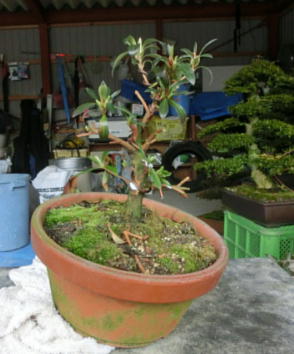
The photos were taken on March 17th. The former is front side of this material and the latter is the back side. The height is 17 cm.
This time I could not refer to the nebari of each material because I did not have any time to spare to repot them and intended to repot them in March or after blooming in 2016. Though it is very important that any daihin, chuhin and shohin have a good nebari (rootage), it will be allowed even if any small or mini bonsai of satsuki tree were not perfect in the nebari. And we will be able to make a root by grafting a sapling on the bottom of the trunk. But since they are short, it is very difficult to make a branch by grafting a sapling on the trunk or by using a drill. Therefore we have to make a good trunk which has a good stream when we grow satsuki trees.
Attentions: The classification of the satsuki bonsai which is set down by Japan Satsuki Association
Daihin part 1: The height of tree is 55.1 cm and over. The width of tree is free.
Daihin part 2: The height is within 55 cm. The width is within 90 cm.
Chuhin part 1: The height is within 45 cm. The width is within 70 cm.
Chuhin part 2: The height is within 35 cm. The width is within 55 cm.
Shohin part 1: The height is within 25 cm. The width is within 37 cm.
Shohin part 2: The height is within 15 cm. The width is within 25 cm.
But each association and society in Japan have their classification of satsuki bonsai. A lot of them have three classifications of daihin, chuhin and shohin. Therefore, generally speaking, the tree whose height is within 20 cm or much lower, is often called mame (mini) bonsai or gokushohin. And since this time I decided to call the material the sapling if it is wthin 3 years old, and the young tree if it is 4 years old and over.
If you would like to understand what Mack is a little more, please click here.
If you have any suggestions or impressions about my home page, please send your e-mail about them to my e-mail address.
Then I will
surely answer them.